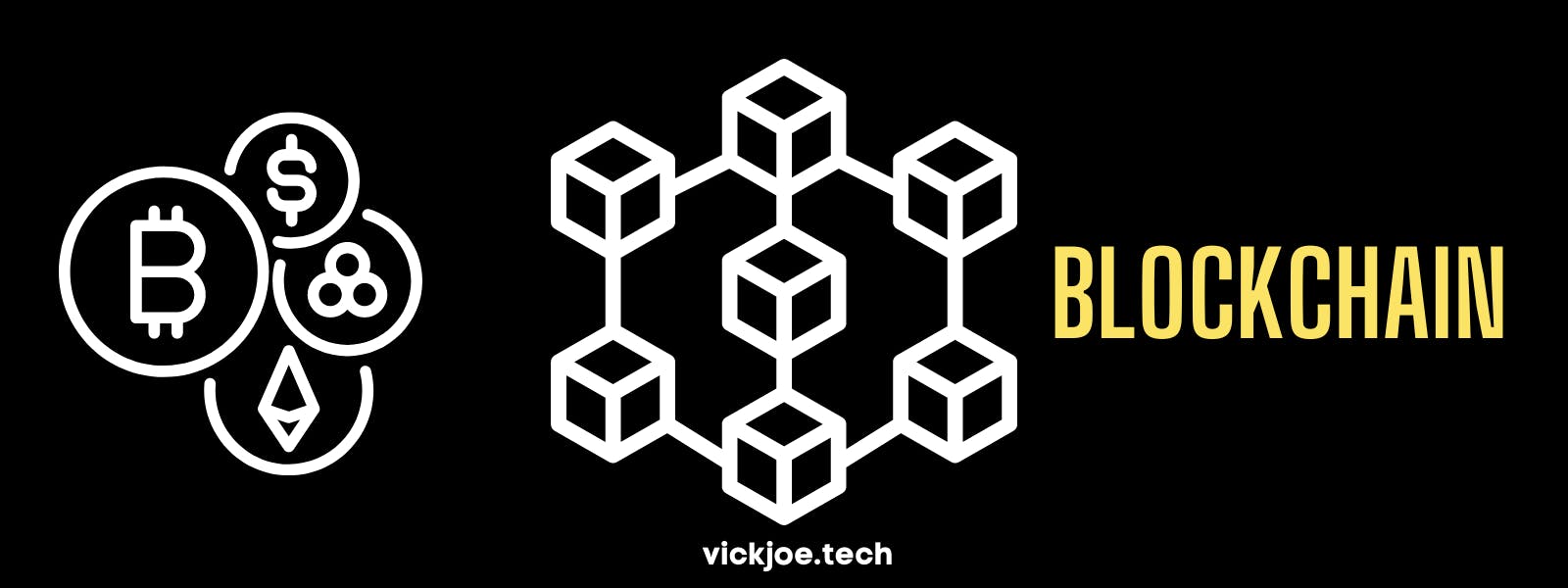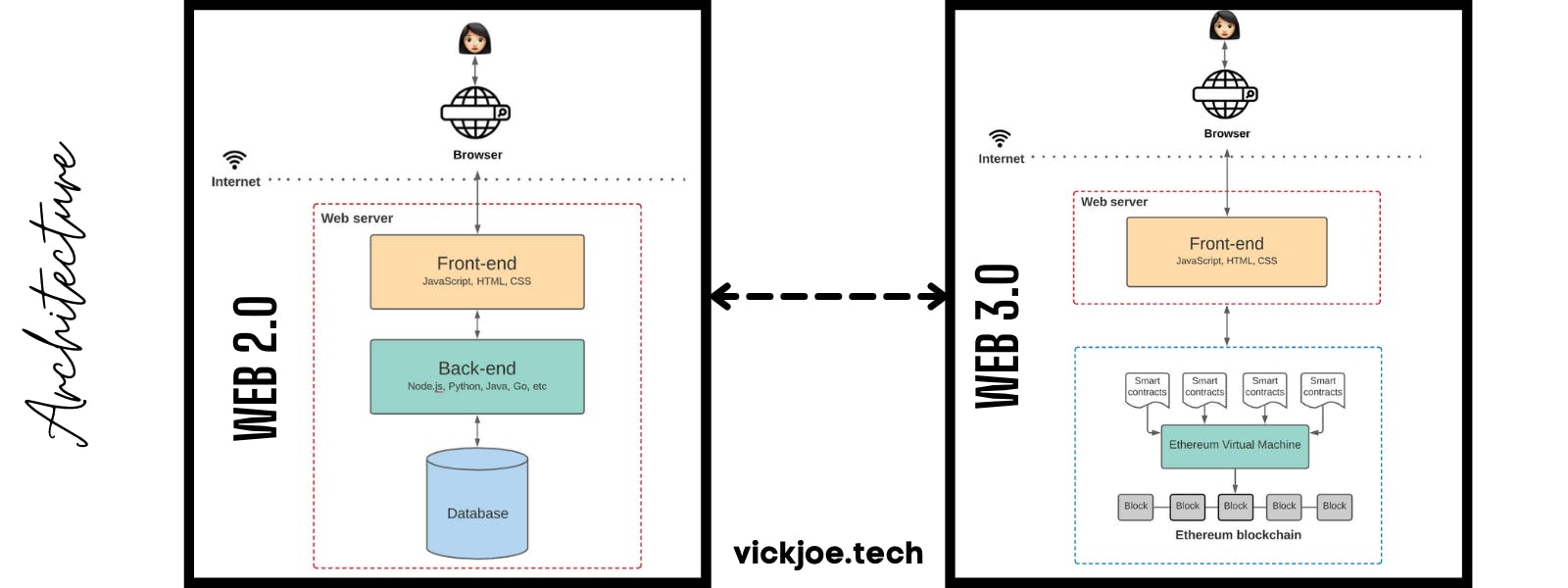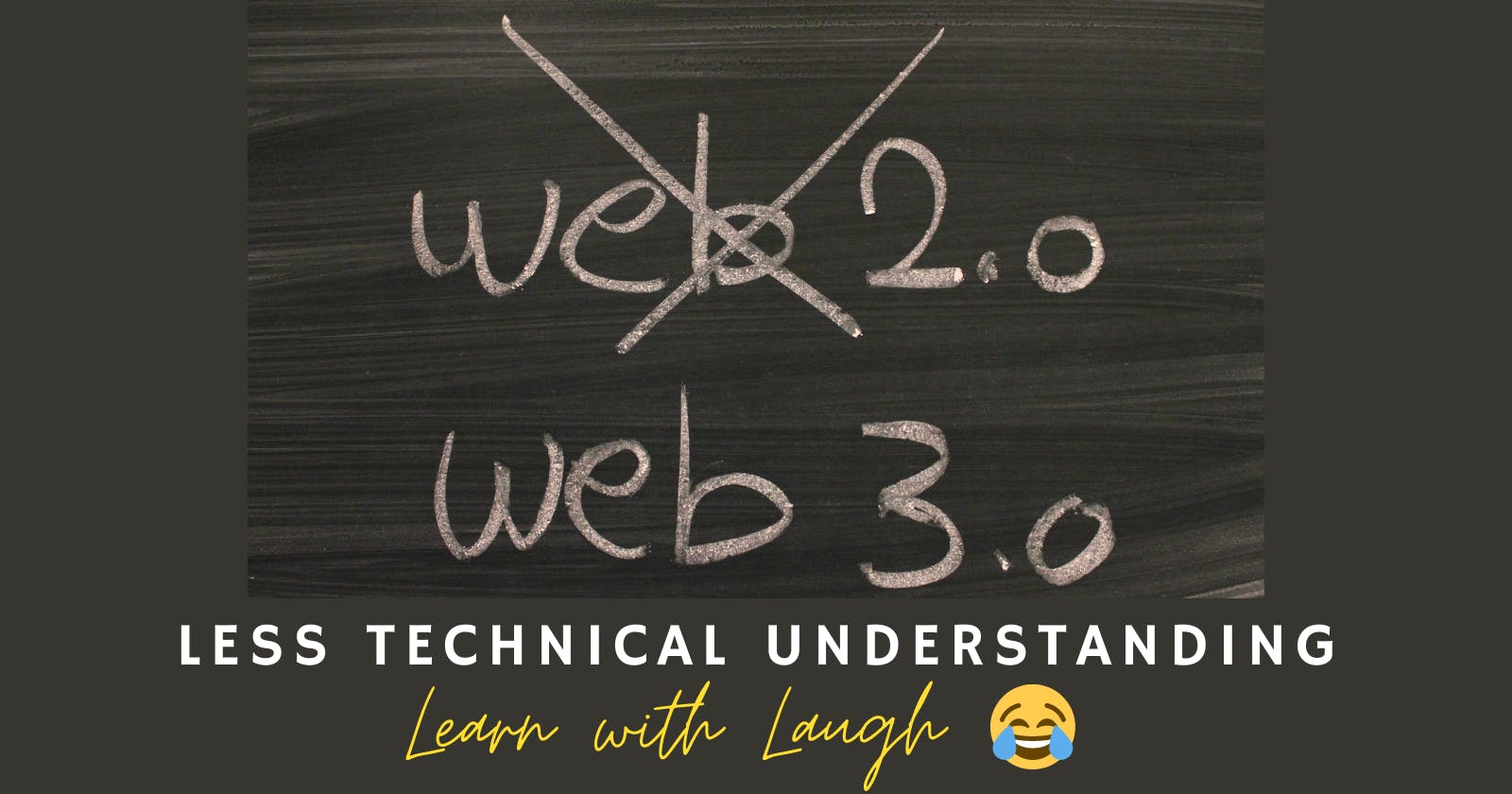Understanding Web 3.0 in a non-technical way.
Here I explain web 3.0 in layman's terms. Of course, we might encounter some technical details in between, but I promise to break it down 😀.
I know you must have been seeing a lot of posts in this space about web 3 right? To some extent you are thinking "Am I in the right space"? Don't mind them, you are in the right space just that I need to update you on the latest. The only difference is that some technologies started becoming more popular now with the rise in popularity of cryptocurrency (of course, you know or have heard of the likes of bitcoin, Ethereum, etc. ). This comes with a lot of other technologies that accompanied it, one of which is web 3.0. In this article, I will explain web 3.0 to you as if you are a baby(though you are not a baby) and make sure you understand it.
* Let's start
I know the problem is not just hearing about web 3.0 but all the crazy words that come with it, like DAO, Smart Contract, Decentralization, Blockchain, etc. Oh, not forgetting NFT (Although I have explained it briefly here). Don't worry I will try to break it down together with the various concepts that appear along the line as I write. This article link from one concept to another, but in the end you will get all the gist just follow along.
What is web 3.0?
Web 3.0 is defined as a worldwide web WWW that is based on blockchain, which is built on the principle of decentralization and token-based economics. Let me break it down starting with blockchain.

What is a blockchain?
A blockchain is a blockchain 😂. As the name sounds it is blocks chained together. Seriously speaking, a blockchain is a recording system where information is recorded in a way that makes it difficult for anyone to delete, change, hack or cheat the system. You are thinking that how is this possible right? Let me break it down even further; imagine you are in a class of 50 students and a meeting was held to start a saving system. To make the saving system transparent everyone will have a copy of all the deposits into the savings account and their details (this is called a block; a block contains transaction information which includes sender, receiver, timestamp, etc), and before anyone deposits money the person must reference the last person to deposit. This means that everyone must have a copy of the transaction. All their transaction copies must be the same (in our example everyone is a node on the network because they all have a copy of all the transactions) and all the transactions must have a reference of the preceding transaction except for the first block in the blockchain which is called the "genesis block". The implication of this is that Mr. A cannot change his copy of the transaction to claim that he saved $30 whereas he saved $5 because his copy of the transaction is quite different from the copy of other people's transaction, this is a distributed Ledger Technology (DLT) system. Distributed because no one person has access to all the transactions in a blockchain. All the nodes that are part of the network have access to the transactions (There are a lot more technical details in between but at least you understand the concept). Some of the key features of blockchain include:
- It cannot be corrupted because every node on the network has a copy of the transaction. Therefore if one node corrupts, the data will be provided by other nodes (there's also an agreement to ensure that majority of the nodes have the same data).
- It is decentralized such that there is no governing body in place or one entity that manages it.
- It is highly secured
- Transparency is guaranteed because everyone can see every transaction that is happening on the blockchain.
- These and several others are the basic features of a blockchain. However, there is one more feature that is very important in relation to web 3, Cryptocurrency blockchain. "Blockchain is the principle on which cryptocurrency is built". Allow me to quickly explain cryptocurrency to you.
Cryptocurrency
Cryptocurrency popularly called crypto are digital currencies (there are other technical jargon in between). The good things about crypto include ease of transfer, security, privacy, etc. It also has a lot of bad sides which include price volatility (the price is not steady), cyber security issues, regulation, etc. Most of the cryptocurrencies we have are decentralized networks in the way that they make use of blockchain technology. Examples of cryptocurrency include Bitcoin (the most popular), Etherum, and a host of other currencies.
Don't forget where we are coming from, Web 3 has been built on blockchain. This same blockchain technology is what cryptocurrencies such as Ethereum use. In everything I have been telling you since the beginning of this article, I have not mentioned web 2.0. Does it mean that it doesn't exist?
Web 2.0 & Web 3.0
I am sorry, everything I have written so far is half-truth. I didn't tell you that web 3.0 is an evolution from web 2.0. Before I proceed into the main gist, get yourself updated with some basic information on web 2.0 and how it also evolved from web 1.0.
Web 2.0 is the era of the web that read-write became popular and readily available. It triggered the era of the social web where user-generated content is being served to end-users. You know your social media sites like Facebook and Instagram by my guy Mark. Lots of people thought it ends here, but the gist continues, it also improved on the centralization of the web. What I mean by this is that few folks have access to all our data and use it for whatever they like but most significantly advertising. If you are a software developer, you would also know the basic process of designing a web 2 application, the normal frontend, backend, etc. That was highly revolutionalized in web 2.0 and it made it easy for us to design beautiful applications. In web 2 we have web frameworks such as React, Angular, etc for designing frontend and node js, PHP, etc for the backend.
Well, I am disappointed to tell you that Web 3.0 took some of the features and tools used in building Web 2.0. You can use the same React used in building the application, the same browser, the same everything. Just tell me the truth, does this not disappoint you 😥? With all the hype and buzz going around web 3.0 I was thinking we are entering into a completely new world. But then again I think the core message or theme around Web 3 is decentralization. To make you understand it better, I will tabulate the difference between Web 2.0 and Web 3.0.
| Web 2.0 | Web 3.0 |
| Web 2 claimed they engineered free speech, yet they tend to censor content in social sites like Twitter, Facebook, etc. | In Web 3 we have freedom at last 🕺🏽. Freedom to live in a censor-free society. This is made possible because every interaction is done on the blockchain. Just imagine a Twitter where every tweet is recorded on the blockchain, you cannot delete a tweet forever. The problem is do I want to live in a censor-free society? I am an anti-troll so I don't know if we all can be good people and behave, else please take me back to 2.0 |
| You know how payment companies decide not to process your payments. For example, because I come from a particular part of the world they might want to censor my money and stop the payment. | That can never happen in Web 3.0. Payment cannot be prevented and does not contain your personal detail. (Don't worry I know FTX or Coinbase made you do verification 😂 before they can accept you). On the blockchain, your only personal detail is your wallet address (This is the address of your cryptocurrency more like your dollar account. These addresses are just a bunch of numbers and alphabets). This cannot be traced back to you at all as you can create as many as you wish anytime you want. |
| Ever heard "Our server is down"? (server is just like a computer that your computer connects to over the internet **There are more to that but this is just a low-level explanation) this can happen in banks a lot. | Our server does not go down in Web 3 ✨. This is because it is connected to a blockchain that uses thousands of computers as a backend. So if one goes offline, another one is online. |
| Transperency is history in Web 2.0. You can only view as much as you are permitted to. This can be due to regulation or corruption, just take your pick. | In our precious Web 3, imagine having the possibility to query a government-owned wallet address to see all the transactions it has performed so far? These and many others are the transparency features of Web 3.0 |
While writing the difference between the two webs, I discovered that the difference alone can make an article, so I had to stop before I overbore you with unnecessary details. At least now you know and understand the difference between Web 2.0 and Web 3.0. I am now confused if I should first tell you the limitations of web 3 before telling you the various use-cases or vice versa. However, to aid your understanding, I will leave you with a picture of the architecture of web 2 and web 3 that I borrowed from our friends at preethikasireddy. I think it is wise I give you the gist about some of the use cases of Web 3.0 that way you can ignore the limitations 🤐.

Use cases of web 3
This is simply where we can make use of Web 3.0. Of course, you know that web 3.0 would be beautiful nonsense if we cannot make use of it in developing things. Sorry to disappoint you we have a lot of cool use cases within the space.
- NFT: I explained NFT in detail here, it is just something that cannot be exchanged for that same value example artwork. Web 3 empowered creators to put their NFT in the marketplace and make money from their work.
- Healthcare: Imagine having an address that no one knows belongs to you, but it contains all your medical history that can easily be accessed by any medical personnel that wants to offer help.
- Everything Web 2 can do 😊: I just discovered that there is no point in writing this usecase. I don't want to waste your time. I think web 3 can do everything web 2 can do in a decentralized manner. Pick any example and convert it to a decentralized application (dApp).
Before I proceed, you need to promise me that you won't get disappointed with the limitations of Web 3.0. Thank you for not promising me, let's go.
Limitations of Web 3.0
Before I can properly discuss the limitations I need to start by explaining the concept of gas fees.
Gas fee
Remember I told you that transaction data or any kind of data is kept as a block in the blockchain. Before such a transaction can occur you will need to make some payments called a gas fee. This is the little money you pay some set of people for maintaining the networks and helping you create a block in the blockchain. It is important to note that almost all types of blockchain adopt the concept of gas fee but might decide to call it anything they wish. The price can also differ from one type of blockchain to another. The concept of "gas fee" is most familiar in the Ethereum blockchain space.
Now that you understand what a gas fee is we can proceed with the limitations of Web 3.0:
- Scalability: Transactions are very slow on the web 3 due to the fact that it is decentralized.
- User Experience: In some of the web 3 applications, you need a specialist-like tutorial to be able to use it.
- Cost: The cost of putting applications in the blockchain is very expensive not forgetting the "gas fee" to be paid every time you want to add or read a block in the blockchain.
There are others, but let me not bombard you with the disadvantages. These are the most important for us to take note of. However, it won't be fair to web 2.0 that I finished outlining the limitations without pointing out that web 3.0 still uses their backend even when they claim they no longer use it, as depicted in the picture above. They use the backend because the cost of deploying all their backend on the blockchain is so expensive 😂, "gas fee" is nobody's mate.
Web 3 and Blockchain
I somehow almost managed to avoid mentioning any specific cryptocurrency all through this article except for when I showed the image of the architecture of web 3 above. The truth is that majority of the web 3 applications are powered by the Ethereum blockchain. This is why Ethereum is considered the standard for web 3. Personally, I can see that changing in the near future especially with the high gas fee one has to pay. I heard of Cardano and Polkadot too as an alternative to Ethereum. I might possibly do an article on that too. I like helping you save money.
Did I tell you that we have had blockchain developers for years back, now everybody is claiming to be a Web 3 developer 🤣. The truth is that a change of title does not mean a change in the job specification. Almost all dev I know is racing towards web 3 to go cash out. Please when you do, just buy me a coffee.
Finally, I won't leave without writing out my thought about web 3, the future looks good. However, web 3 communities need to learn to be more engaging than aggressive to people that do not align with the ideology of web 3. We all know that web 3 is just web 2 with a small blockchain added to some part of the backend. One can even argue that they are all the same. I, therefore, hope that I won't come here in the next months to write about web 4, web 5, or web 6 let us stop at web 3 for now.
Oh!, and before I leave, if you enjoyed what you read, please buy me a coffee @ https://www.buymeacoffee.com/vickjoe just make sure they don't add cold milk.
In the course of writing, I peeped into the following articles en.wikipedia.org/wiki/Web3 euromoney.com/learning/blockchain-explained.. investopedia.com/terms/c/cryptocurrency.asp ethereum.org/en/developers/docs/web2-vs-web3 investopedia.com/terms/g/gas-ethereum.asp#:... preethikasireddy.com/post/the-architecture-..

